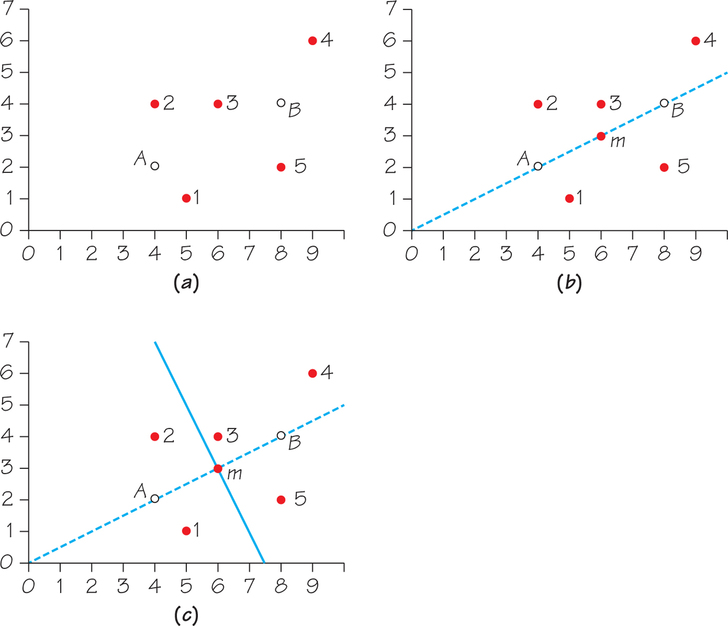EXAMPLE 6 Two-Dimensional Spatial Voting
Two-Dimensional Spatial Voting
Five board members of a company must decide between two other board members (A and B) for the vaunted position of chairman of the board. The voters are concerned with two issues: overseas expansion and the timing of the initial public offering. The voters’ ideal points and the candidates’ policy positions are ordered pairs (x,y), where x indicates the position on overseas expansion (a larger value of x means a more vast expansion) and where y indicates the time until the initial public offering (a larger value of y represents a longer time until the initial public offering will be held).


Plotting Points in the Plane
Assume that A and B announce policy positions of (4, 2) and (8, 4), respectively. The ideal points of board members 1 through 5 are (5, 1), (4, 4), (6, 4), (9, 6), and (8, 2), respectively. The policy and ideal positions are graphed in Figure 12.3a.

Distance and Midpoint Between Two Points in the Plane
The midpoint of (4, 2) and (8, 4) is on the line that connects these points; this is the dashed line in Figure 12.3b. The midpoint is calculated by taking the average of each coordinate. The x-coordinate of the midpoint is (4+8)/2=6 and the y-coordinate of the midpoint is (2+4)/2=3. Equivalently, the midpoint satisfies
m=[(4, 2)+(8, 4)]/2=[(4+8, 2+4)]/2=(6, 3)
Just as the midpoint of two policy positions divides the left-right continuum into three regions in which (1) voters prefer one policy position, (2) voters prefer the other policy position, and (3) voters are indifferent to the choice between the two policy positions, there is also a way to use the midpoint to divide the two-dimensional policy space into three similar regions. In high school geometry, we learn how to draw a line through a point that is perpendicular to another line, using either a compass or dynamic geometry software.
The solid line in Figure 12.3c is through the midpoint m and is perpendicular to the dashed line between the policy positions of A and B. It divides the two-dimensional space so that voters with ideal points below the solid line prefer A over B, voters with ideal points above the solid line prefer B over A, and voters with ideal points on the solid line are indifferent between A and B. Board members 3, 4, and 5 have ideal points above the solid line and vote for Candidate B, while board members 1 and 2 have ideal points below the solid line and vote for Candidate A. Board member B is elected as chairman of the board.
